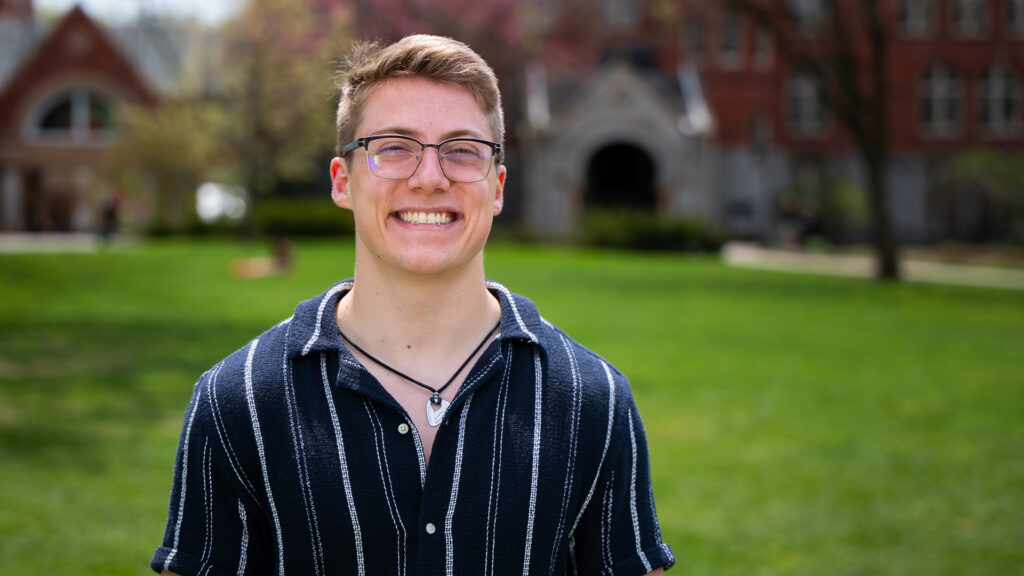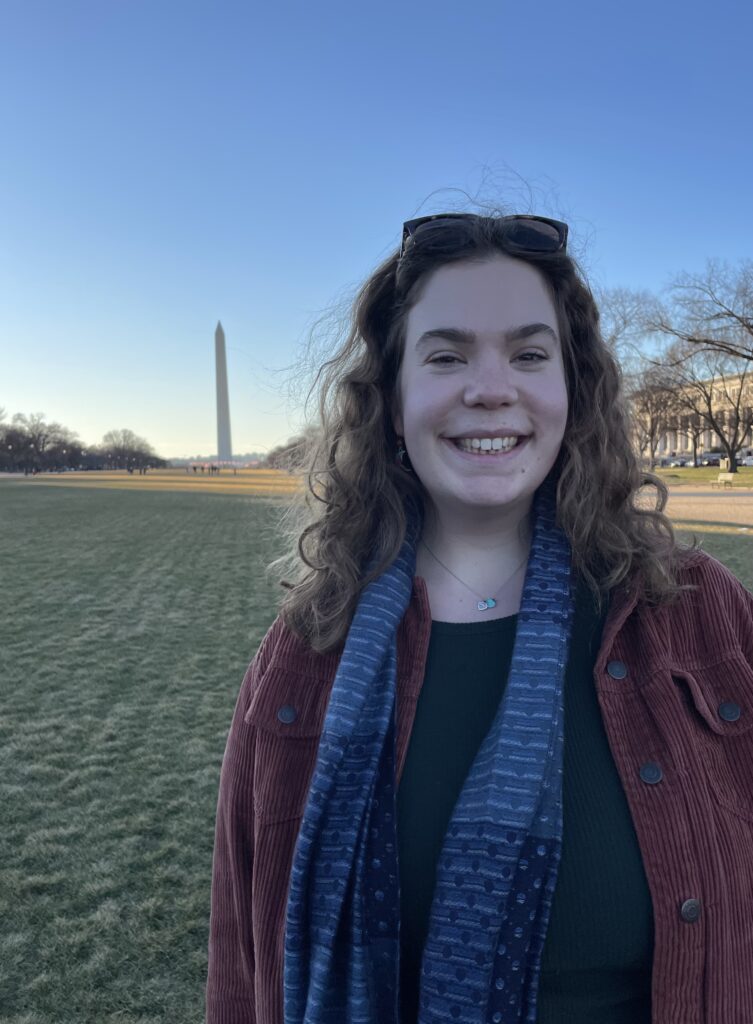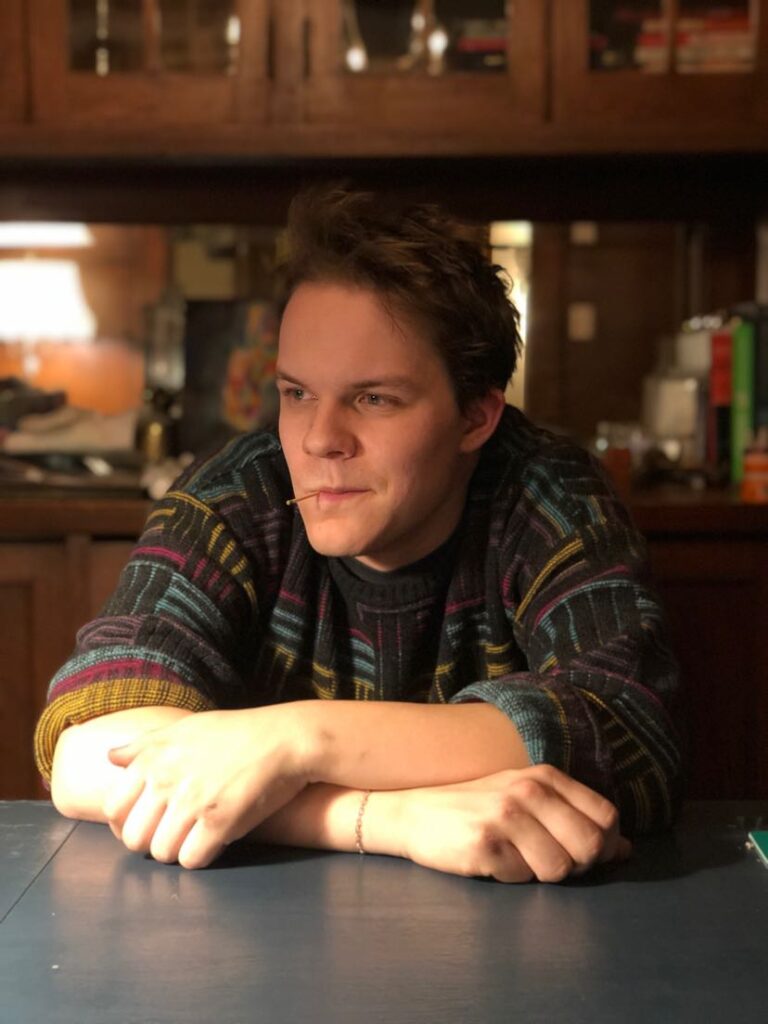
By Talia Bank ’23
Each year, Mac seniors dig deep into independent research through honors projects and capstones. Their projects are opportunities to add to the conversation and showcase their expertise. We asked five seniors to tell us about their work.
Comparing Chinese Investigative Journalism in Two Pandemics
As an aspiring journalist from China, Grace Xue ’23 wanted to examine how Chinese journalists covered the SARS and COVID-19 pandemics and how their investigative journalism compared over time. In her project—”Watchdog” or “Lapdog”: Comparative Study on Chinese Investigative Journalism in SARS and COVID-19 Pandemic—she found that while newsrooms better equipped their journalists to report critically during the SARS pandemic, investigative reporting in the COVID-19 era is more subtle and covert.
“I think a lot of people think journalism in China is declining because of a lack of freedom of speech, but the truth is there are more nuanced and complicated factors behind this general statement. There is a gap in communication studies with disaster-related reporting in China, so I wanted to do research on that, because it’s not just about what happened, but also why it happened and what people should do to solve it.
I did a discourse analysis of three different Chinese newspapers and their coverage of SARS and Covid to compare content, style, and tone of the text. I read through over 50 different Chinese articles and came up with qualitative analysis based on my own perspective, and I also interviewed a few Chinese journalists who covered SARS or COVID to get their perspective on journalism practices in the industry right now.
I found that there is definitely less investigative reporting with COVID coverage, compared to SARS. However, it’s not like everything is just propaganda; I think journalists are still actively participating in critical reporting, but in very indirect and subtle ways. For example, they will use more suggestive questions instead of direct assertive sentences to offer solutions instead of really criticizing something.
We need more investigative journalists, because journalism is important for society to improve itself. We have flaws in different systems—corruption and wrongdoing—and we need journalists to investigate those problems. They communicate and mediate between the government and the public; it is a really crucial role. It is not that journalists are trying to damage the image of the government. They are acting in the public interest.”

Personalizing Medicine With Genetic Testing
Mason Chambal ’23 based his project on an internship with The Christ Hospitals Health Network, where he worked with their precision medicine program. Through hands-on learning, he became fascinated with precision medicine’s innovative and individualized approach to health care, so he turned his research into an honors project on pharmacogenomics, a medication management strategy within precision medicine. His paper—”Comparison of Expanded Panel Testing vs Targeted Testing in Pharmacogenomics: What Are We Missing?”—was published in the Journal of the American Pharmacists Association in March.
“Precision medicine is basically personalizing medicine—it fits the medications you take to your genetic profile. We know that genes make enzymes that affect the absorption of medications, so I was looking at different ways of testing your genes and how we can look at all of your genes holistically to capture all the different medications that are affected.
Normally people are prescribed medications based on the average or typical version of the gene that affects how you metabolize that medication. But if you aren’t the average or if you have a different variation of the gene, you won’t be able to process the medication the same. You are going to end up having an adverse response to it or it might not be as effective as you need it to be. Pharmacogenomics is basically saying, ‘Hey, let’s look at your genetic profile and determine what medication to give you based on that.’ It is super logical.
You want metabolization to take the right amount of time. So for example, if you take one Advil for a headache and it doesn’t go away and you take another, that is still a good amount for the typical person. But if you don’t break it down as well, meaning it stays in your system for longer, then your headache might go away with just one. But with some medications, it is really dangerous to metabolize them for too long. If Advil was super dangerous and two is a good amount for the typical person, you may take two and not break it down as well so you get the effect of four. Pharmacogenomics tries to get that same effect for different people.
It’s more complicated in the real world because each gene is also going to affect a bunch of different medications. You can look at that: you can test your gene, see what possible variations it has, and you can know how it will affect a certain medication. But this targeted gene testing only tells you about the specific medication, so you are missing how that one gene affects many different medications that are not always even for the same area of medicine.
So I ended up publishing my paper that asked, ‘What are you missing when you do targeted testing?’ And the answer is you’re missing so much. You can have multiple variations in one patient, and each variation can affect multiple medications.”

Incorporating Neurodivergency into Dance Performance
Emilia Garrido Vazquez ’23 channeled her experience as a neurodivergent dancer to explore how self-regulating repetitive movements—stimming—can be a part of dance choreography and performance. Her honors project included a performance with both solo and group dances where she incorporated stimming motifs into her choreography and aimed to communicate the ways she felt both included among other neurodivergent dancers and excluded from mainstream classical dance. Alongside the performance, Garrido explores these themes in her paper, “Stim Dancing; The History of Incorporating Neurodivergent Movement in Dance Performance.”
“As a classical ballet dancer, I really struggled with memorizing choreography, counting measurements in music, marking out combinations, and processing information. It was a challenge because I was always moving and fidgeting when my teachers expected me to be still. They considered stillness an indicator of attention, but fidgeting and moving helps me process information and learn combinations. Even though I understand music in dance, I was not understanding it in the way that other people did. I later realized that the reason this was challenging was because I’m neurodivergent, which is why I wanted to write about it. It was not because I was not as talented or not as good of a dancer. It was because I don’t think I was accommodated in the ways that I needed to be able to succeed.
I decided to focus on creating an environment that is accommodating and inclusive of neurodivergent people in dance by incorporating stim language into dance choreography. For instance, if my nose is really itchy because I have allergies, I can bounce my head several times and to me that could be stim dance. I could say this movement comes from a need that I had when I was trying to self-regulate my allergies. I struggled a lot to define stim dancing and stim movement, because it looks so different for everybody. In my dance piece, I featured some of my everyday stims, and also incorporated stims from my dancers. The intent behind stim dancing comes from a place of aiming to self-regulate. This need to self-regulate can be choreographed and it can also be improvised. The music in my piece also had live performance components, where my musicians were able to explore their own stims through singing and music.
Stim movement really needs to find its place in the world of dance as a valid form. It can be so powerful to see stim dance language and stim dance motifs in choreography. It makes the creative dance process more inclusive.
What I was trying to express in my performance in the spring dance showcase was what can it look like for the dance space to be cohesive and inclusive. I wanted to address what I felt in the dance community as a neurodivergent artist. The improvisational movement really came from a place of trying to self-soothe, trying to self-regulate, and really trying to come back to a home base of feeling okay and embodied in myself. It was really lovely to be able to choreograph something that still felt like me—formal and pretty and symmetrical—but was also an exploration of how to do something different and have it come out funky and weird and interesting-looking.

Exploring the Foundations of US Gun Culture and the Second Amendment
For her honors project, Lola Brown ’23 asks why the Second Amendment’s right to bear arms has come to center the founders’ intent and why the narrative around gun rights looks the way it does today. Her deep-dive bridges history, political theory, and law, highlighting the historical choices that have influenced contemporary U.S. gun culture. In April, Brown presented her project—”Interpretations of Intent: Sovereignty, the Second Amendment, and US Gun Culture”—at the annual Midwest Political Science Association Conference.
“I started this project wanting to look at how US gun culture exists the way that it does and why. I was really curious about the Second Amendment and the contemporary [legal] understanding that ‘This is what the founders wanted and that’s why we can’t have gun control.’
Why have we come to that conclusion? That’s the question. That brought me to the ideas that created the Second Amendment, like sovereignty. From a political theory standpoint, conceptions of sovereignty informed the American Revolution and created the Second Amendment.
I went all the way back to the Middle Ages and charted the transition from feudal lords to monarchs and the concept of absolute sovereignty. The founders were not fans of absolute sovereignty. That’s what the American Revolution was about—bringing about this idea of popular sovereignty where the people were going to be the authorities in this country. This is what the creation of the Second Amendment is all about.
The other delineation point was the formation of a federal army for national defense purposes. Thomas Jefferson, among others, was worried that the federal government would use that army to infringe on the power of the states. But from the federal standpoint, the government cannot insist that all of these states come up with their own state militias. But what they could do was say that every individual could have a gun in order to form a state militia.
The crux of my project is that the foundational idea is about sovereignty rather than personal rights. That, however, is not relevant [to gun rights] today. We now have funding mechanisms and state constitutions that protect our states. We don’t need every head of household to have a musket in order to drop everything and form a state militia at the drop of a hat.
I presented my project in Chicago [at the Midwest Political Science Association Conference] with a couple members of my honors cohort and some of our advisors, which was really fun. It was so cool to see what life in academia could look like. It was a good Macalester moment for us.”

Building “Home” Through Art
As a senior, Owen River Burgdorf-Hibbs ’23 embarked on his honors project thinking a lot about what it means to leave childhood, enter adulthood, and reconstruct the idea of home elsewhere. He settled on the three main themes of quarrels, security, and companionship to describe the concept of building a “home,” and shaped his honors project, “Build-A-Bode,” into a three-piece art exhibit based on plastic model building kits.
“I do a lot of miniature work, so for this I wanted to flip that on its head. I imitated old model kits that come on these plastic sheets that you use to break off all the plastic parts piece by piece and recreated that with life-sized objects. It was also important to me to be using things from my basement and storage unit; there’s care and time and a history there and I wanted to pick up on that.
I identified quarrels, security, and companionship as elements of home that we get to pick up and choose how those are fulfilled. They’re very autobiographical to my own life and experience, but I wanted them to be broken down into broader concepts so that everyone could relate to this.
My idea for companionship was that some people find that through pets, music, books, some people have plants, and so on. There’s a mirror because for some people, you are all you have for companionship and that can be enough. So it’s important to me to recognize that people find those needs in their own home in very different ways.
For quarrels, I have things like shoveling the snow, laundry, trash, recycling. People argue about both clean dishes and dirty dishes, as well as a thermostat. So for me, quarrels are included as kind of fun and funny and a little bit cheeky since these things happen when you’re comfortable in a space of home and that is what shifts them away from true arguments into something more like quarrels.
The one thing that is a little different about security for me is the idea that other people might break off these pieces for you. The teddy bear, for example, is about childhood security, and that’s something that most people don’t really have the luxury of choosing or not choosing for themselves. I also included pill bottles for health security, a piggy bank for finances, keys and locks for physical security and privacy, and then the security camera to allude to a problematic sense of security and protection.
It has been a crazy process. I wanted them to have a manufactured feeling, so I used a laser cutter and spray paint. A big part of this was also keeping it neat and clean so that they look like they could be plastic. It was about reframing my anxiety around reconstruction of home as something that’s a gift, something that we get to do. It’s a time when you can evaluate and reevaluate your priorities and what matters to you in a domestic space and within a mental space of home as well.”
May 15 2023
Back to top




